This is a Zeiss-Ikon Nettar 515 which is a medium format folding camera which takes sixteen 6cm x 4.5cm images on 120 roll film. This was the third model in the long-lived Nettar line and first went on sale in 1937. The Nettar line of cameras shared many design similarities with the higher spec Ikonta line, and was aimed at the amateur market. Despite it’s status as a “lesser” camera to the Ikonta line, it was a very well built camera that shared many body parts including the hinges and gears with it’s big brother. The lenses and shutters in the Nettar line were often lower spec without the wide range of shutter speeds, yet the cameras were often capable of good to excellent shots. The entire Nettar line was produced through the late 1950s and had models that shot in a variety of aspect ratios such as 6cm x 6cm and 6cm x 9cm.
Film Type: 120 Roll Film (16 exposures 6cm x 4.5cm per roll)
Lens: 7.5cm f/4.5 uncoated Novar Anastigmat 3-elements
Focus: 1.2m to Infinity
Type: Scale Focus
Shutter: Zeiss-Ikon Klio Leaf
Speeds: T, B, 1 – 1/175 seconds
Exposure Meter: None
Battery: None
Flash Mount: None
Manual: https://www.flickr.com/photos/diabolical_science/sets/72157616503712908/with/3424023058/
History
The name “Zeiss” has a long and storied history in the optics industry. It is a name that still exists to this very day as a brand of lenses used by Sony. The Carl Zeiss Foundation still operates today as a maker of a wide variety of products. As recently as 2014, the Carl Zeiss Foundation employs nearly 25,000 workers with annual sales of over 4.5 billion Euro.
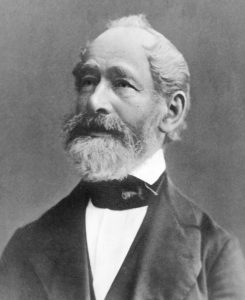
Originally founded in 1846 by physicist and mathematician Carl Zeiss as Carl Zeiss Jena, it’s first products were microscopes and other scientific instruments. The name “Jena” refers to the town the company was founded in, Jena, Germany. In 1872, Carl Zeiss would hire physicist Ernst Abbe who would develop something called the Abbe Sine Condition which improved our understanding of how light passes through glass. It was this discovery that led to the creation of Zeiss’s finest lenses. Upon Carl Zeiss’ death in 1888, the company would change it’s name to Carl-Zeiss-Stiftung (Carl Zeiss Foundation in English) and the company would continue on as a leader in the photographic lens industry.
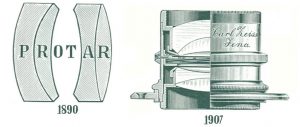
Zeiss’ first photographic lenses were designed by scientist and optician, Paul Rudolph and were called the Zeiss Anastigmat. These first anastigmat lenses had 4 elements and were released in 1889 and eventually were given the name Zeiss Protar. Over the course of the next 2 decades, Rudolph would continue to improve upon his optical formulas and would revolutionize the lens industry releasing pioneer designs like the 6-element Planar and what would become the company’s signature lens, the Tessar in 1902.
An interesting bit of history behind Zeiss lenses is that although the Carl Zeiss Foundation did make their own Zeiss branded lenses, the company would also license the optical formulas to other lens makers such as Bausch & Lomb in New York, E. Kruass in Paris, and Ross in London. This helped the company gain worldwide notoriety by quickly spreading it’s name and designs to manufacturers all around the world without having to physically expand into these markets. It was a risky move as Zeiss had to depend on these other companies to physically make their lenses true to the original designs, but it ended up working as Zeiss quickly became one the most highly regarded optical companies of the 20th century, a name that continues to be used today.
In the first two decades of the 20th century, the German camera industry was highly successful. There were dozens of pioneering companies making all forms of innovative cameras, lenses, and other optical equipment. Aside from the George Eastman company out of Rochester, NY, the majority of the world’s photographic industry was based around these German companies. In 1926, four different companies (Contessa-Nettel, Ernemann, Goerz, and Ica) would all merge together with financial backing from the Carl Zeiss Foundation, and form Zeiss-Ikon. While I could not find any evidence of this in my research, my guess is these 4 smaller companies felt they could be more competitive by joining forces in the increasingly competitive photographic industry.
Although the Carl Zeiss Foundation would maintain it’s presence in Jena, the newly formed Zeiss-Ikon would dominate what would become the East German camera industry in Dresden. A large percentage of Zeiss-Ikon cameras would come with Zeiss brand lenses. It would sign contractual agreements to use Compur shutters in a majority of its mid to high spec cameras. Only the more basic cameras would be allowed to use “lesser” shutters or non Zeiss lenses.
In their early years, Zeiss-Ikon would primarily make folding plate and box cameras, but in 1929, would release a new line of folding cameras designed for roll film called the Ikonta. The Ikonta line would be very diverse, consisting of models that used 120, 116, 616, and 127 format film. The Ikonta line would last for about 30 years, concluding with the Super Ikonta 534/16 of 1959.
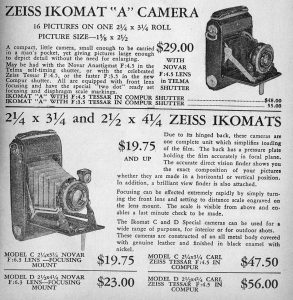
All Ikonta cameras were very well built and came with high spec shutters and lenses, and cost quite a bit of money for the advanced amateur photographer. A 1935 catalog from Central Camera in Chicago shows imported Ikomats (the US version of the Ikonta) starting at $19.75 for the Model C with Novar f/6.3 lens and going as high as $56 for a Model D with Zeiss Tessar f/4.5 and Compur shutter. When adjusted for inflation these prices are $347 to $985 in 2016.
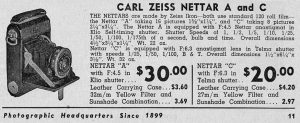
A couple of years after the release of the Ikonta (some sources say 1933, some say sooner), Zeiss-Ikon would release a line of lower spec Ikontas which they branded as the Nettar. The Nettar line would be similar to the Ikonta line in that they were medium format folding cameras that came in a variety of aspect ratios. In many cases, body parts, hinges, and viewfinders would be shared between the Ikonta and Nettar line. Look at the stock photos in the two catalog pictures to the left and the right, and you’ll notice that the cameras look nearly identical. Although some Nettars could be purchased with Compur shutters, they generally had more basic Derval, Telma, and Klio shutters with Novar Anastigmat lenses.
A 1943 catalog from Central Camera in Chicago lists a Nettar A with a Klio shutter and f/4.5 lens selling for $30 and a Nettar C with a Telma shutter and f/6.3 lens selling for $20. Its worth noting that comparing the two ads above is a little difficult since there was a huge amount of inflation between the 1935 and 1943 catalog. Using the CFI Inflation calculator, the Nettar A and C from 1943 would have cost $23.76 and $15.84 in 1935, respectively. When adjusted for inflation, this amounts to $417.98 for the Nettar A and $510.23 for the Ikomat A in 2016 dollars. Add a Tessar f/4.5 lens and Compur shutter to the Ikomat and that amounts to $844.51 in 2016 dollars, double that for a comparable Nettar!
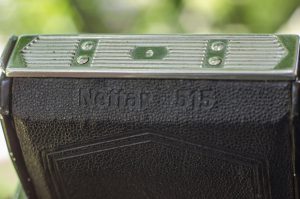
The model I am reviewing here is called the Nettar 515 which was in production from 1937 to about 1940 when it was replaced by the Nettar 516. The 516 added double exposure prevention and a revised selection of lenses. There was also a 6cm x 9cm version of this camera called the Nettar 515/2 which actually debuted in 1933, four years prior to the “regular 515”.
After World War II, Zeiss-Ikon would be split into separate West German and East German divisions. The East German version of the company would remain in Dresden and would become a state owned corporation and it’s name would be changed to VEB Zeiss Ikon Dresden. The name would be changed once again to VEB Kinowerke Dresden in 1958 and then VEB Pentacon Dresden a year later.
The West German version of the company would continue to use the Zeiss-Ikon name as Zeiss-Ikon AG Stuttgart, but would struggle due to the weak post-war German economy and in 1965 would merge with Voigtländer, another highly regarded camera manufacturer. Zeiss-Ikon would continue to sell cameras under it’s own name until around 1972 when the company would cease operations altogether. What remained of the old Zeiss-Ikon company would be purchased by Rollei where the “Contax” brand was revived and licensed to Japanese camera maker, Yashica.

In the decades after the war, despite the confusing state of both Zeiss brands, they would maintain their reputation as a world class camera maker, but it would be their lenses that would continue to be the “banner” product in their portfolio. Zeiss would continue to refine and improve their optics. The Tessar design would be the most copied lens design in history as manufacturers from the United States, the Soviet Union, Japan, France and Italy would all have “Tessar style” lenses.
During my research for this article, I found the entire history of the Zeiss brand to be pretty confusing, especially from the 1970s – 90s, but it seems that the Carl Zeiss Foundation still existed and after the reunification of Germany in 1989, would attempt to revive the Zeiss-Ikon brand. In 2005, an all new rangefinder known as the Zeiss-Ikon ZM would be released. Built by Cosina in Japan, it would use the Leica M-mount and would be seen as a successor to the Leica M7. It would be built alongside the Cosina made Voigtländer Bessas and would use the same lenses. Although this camera is no longer made, Zeiss still has a full product page for it on it’s website.
Today, the Zeiss brand is still highly regarded and as such most of their products are appealing to collectors. The Nettar line usually doesn’t go for very much on the used market, but examples in good condition can easily fetch prices as high as $50 on eBay. For someone looking to shoot with a pre or post war Ikonta, but doesn’t want to spend the money that those cameras typically sell for, the Nettar is an excellent alternative. The bodies are nearly identical, and if taken care of should still operate with the same precision as they did when they were new. Although the more basic shutters and lenses don’t have the impressive technical specs of a Compur/Tessar combo, they are still capable of wonderful shots.
My Thoughts
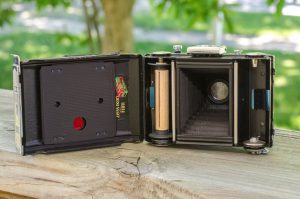
The Zeiss-Ikon Nettar was never a camera I had set my targets on, but after owning a couple of Japanese 6cm x 4.5cm folding cameras which were heavily based upon the Ikonta A, I started to develop a fondness for the compact 645 format.
Then, on Father’s Day 2016, my wife said she had a present for me. She handed me one of those colorful gift bags filled with tissue paper and upon opening it up, I pulled this little black leather and nickel camera out of it. Now, before I go on, I have to say that my wife repeatedly rolls her eyes at my camera hobby. While she doesn’t directly oppose it, she thinks the whole concept of owning more than a few cameras is downright silly. She sees the enjoyment I get out of testing and reviewing these cameras, so I guess she thinks that there’s far worse things I could be doing with my money and free time. She’s even asked to shoot a couple of my cameras once or twice, but beyond the occasional “oh that’s neat” from her, she’s rarely shown any interest in expanding my collection.
So upon pulling that camera out of the bag, I couldn’t believe my eyes. She had a nervous smile on her face because she told me she picked this thing up the day before at a random estate sale. She had a doctor’s appointment to which she was going to get there an hour early, and she saw the sign for the sale and figured that would be a good way to kill some time. The estate sale was on “the good side of the tracks” and as such the house had a lot of high priced items. She saw nothing of interest in the house, and was ready to leave, but then she saw this little gem sitting on a kitchen counter. She said two guys were going back and forth on a price for some other item, when she asked the guy if he would take $15 for the camera, and without hesitation, he said “yeah sure” and went back to negotiating with the other guy over something worth quite a bit more.
Not knowing anything about this camera or what it was worth, she didn’t know if $15 was the deal of the century, or a complete waste of money. She said it pained her to not be able to call me to ask my thoughts on it, but she wanted to surprise me with it, so she had to bite her tongue.
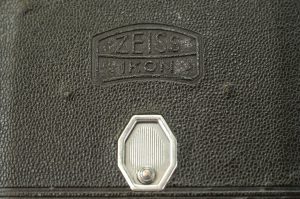
As it would turn out, her instincts were quite good. I’ve said in other articles that you can often rely on the physical shape of a camera to determine it’s condition. If it looks nice, there’s a good chance it works fine and that held true here.
The thing is, this Nettar didn’t just look nice, it was gorgeous. It was in nearly perfect condition. The inclusion of a wooden spool in the film compartment suggests that it’s seen very little use in it’s 80 or so years since it was made. The lens had no noticeable scratches, haze, or fungus and the bellows were supple and light tight. The body covering wasn’t peeling and there was no chipped paint. There was no corrosion anywhere on the body other than two very small Zeiss bumps on the film door. The focus, aperture, and shutter movements all worked wonderfully. She had no idea of how to even fire the shutter, so after I went through it’s functions, I did notice the camera’s one and only fault was that the slow speeds were sluggish. I can easily clean this shutter and restore the slow speeds, but the fast speeds 1/50 and up all sounded good to the ear. I told her how good of a job she did on this and how happy I was with the camera and she was really relieved.
I saw this as an opportunity to increase her interest in my hobby, so I felt as though I should take advantage of her excitement and move this camera up in the queue faster than I otherwise would with a new acquisition. I can wait to clean the shutter to restore the slow speeds later. As luck would have it, the next weekend we had a trip planned for a family reunion in Eau Clare, Wisconsin, so I knew this would be one of the cameras that needed to come with.
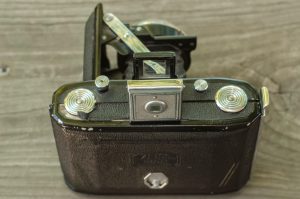
The Nettar is pretty similar to other 6cm x 4.5cm cameras like the Japanese Kuribayashi Karoron and the Zenobia which are essentially clones of the Ikonta to which the Nettar is based off. Like those cameras, the shutter release is on the left side of the top plate. The button to the right of the viewfinder is the release for the door catch. This is a self erecting camera, but it does need some help to fully open the camera, but otherwise is a snap to get open and ready to shoot in less than a second.
Unlike those Japanese cameras however, this one has a flip up viewfinder like that of other pre-war cameras. Although more primitive and probably less accurate due to the moving design, I actually find these flip-up viewfinders to be easier to use. For one, they are larger and easier to clean than most rigid viewfinders. But also, their moving design allows for a little bit of fore/aft adjustment which acts as sort of a primitive adjustable diopter. I made a similar observation in my review for the Kodak 35 that when wearing prescription glasses, this style of viewfinder allows for easy compensation for people like myself with poor vision.
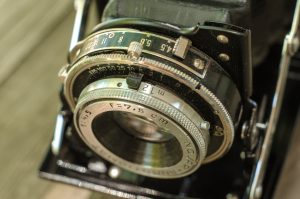
Adjusting focus is just a matter of rotating the entire front lens element. My example had distance markings in meters. Based on the presence of this model in a Central Camera catalog, this model was exported to the United States, so its plausible that some examples exist with markings in feet, but I cannot be sure.
The shutter speed selector is a rim set design similar to most other German shutters like the Prontor or Compur. The Klio shutter has an odd maximum top speed of 1/175. I wonder why they didn’t just list it as 1/200 since spring loaded shutter speeds weren’t that accurate anyway. Despite this relatively slow top speed, it was more than adequate for film of the era which rarely exceeded ASA 50.
Finally, moving the aperture selector is a simple movement of a metal tab near the back of the shutter. At it’s widest, the maximum aperture was f/4.5 which was standard for low spec lenses of the day and more than adequate for almost all outdoor lighting situations. Interior shots would definitely require stabilization and use of the slower speeds, or even the T or B modes.
I really enjoyed shooting my first roll through the Nettar and had pretty high hopes for the the images it captured, but would my positive experience using the camera result in good images?
My Results
I shot my first roll using slightly expired Portra 160. The film was less than 10 years old, so I just shot it at box speed and upon receiving the results, I can say that not only did the film perform quite well, the camera exceeded my expectations.
I was extremely pleased with these results. Taking into account that all I did to this camera was wipe it down when I received it, the shutter is clearly working at nearly correct speeds. I nailed the exposure using Sunny 16 on all shots. Although a few of my shots did not have perfect focus, I believe them all to be either due to body movement or just my inexperience with this particular model. To get more than half of an inaugural roll in focus on a scale focus camera like this tells me the issue is with the photographer, not the camera. Finally, the bellows showed no signs of light leaks. I did not see any streaks or any other lighting anomalies anywhere on any of the images.
The Nettar is supposed to be a “lesser” camera to the Ikonta. It has a “lesser” Novar lens and a “lesser” Klio shutter. Based on the two advertisements earlier in this article, when adjusted for inflation, in 2016 dollars a Nettar A similar to the model reviewed here with f/4.5 lens and Klio shutter would cost $417.98 today, and a Ikomat (US version of the Ikonta) with f/4.5 Tessar lens, and Compur shutter would cost $844.51. While using an inflation calculator to compare two different import cameras based off catalogs that are 7 years apart might not be the most exact way to measure, even if my math is a bit off, it proves that the Nettar was a significantly less expensive camera to the Ikonta/Ikomat of the same era.
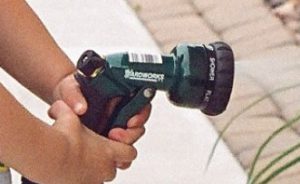
Despite this nearly 50% price difference, I can’t honestly see how the Nettar could be considered anything but an equal to the Ikonta. You should also take into account that back in the 1930s and 40s, the quality of the film and our ability to “scan” negatives was significantly less advanced than it is today. Using modern film like Kodak Portra 160 and a modern digital scanner, I am able to extract more detail out of the negatives than anyone could have seen 80 years ago. If there was a difference in quality between what I got using this Nettar compared to an Ikonta, I should have been able to see it using these scans, and while I don’t have an Ikonta to compare to, I have seen negatives using other cameras with Tessar lenses, and I simply do not see a difference.
The question of “whats a good first medium format camera” gets asked often. While the answers to that question will vary wildly based on who is answering it, I can wholeheartedly say that a Nettar 515 with Novar f/4.5 lens and a Klio shutter is as good as any. The camera is extremely well built, and assuming it was stored properly, should work fine today. It has a lens and shutter combination that looks average on paper, but in actuality can deliver results as good as anything else out there.
If I had to be extra critical of the shots posted above, the one of the bearded man sitting in a chair shows some noticeable vignetting in the corners. In my opinion, this actually looks quite nice, considering the portrait nature of the photograph, but there could be those who do not prefer that look. The vignetting was not visible in any of the other shots, but that could be due to the fact that this very same shot was the only one not shot in direct sunlight. Perhaps the Novar lens only begins to show it’s weaknesses when the lighting is less than perfect.
Not that anyone needs any more evidence that Zeiss-Ikon made great cameras, but when you get great shots from what was considered to be a “budget” model, you know that it can only get better from there. I love the 6cm x 4.5cm format. Despite it being the smallest of the medium format aspect ratios, the exposed image is still over 3 times larger than that of a 35mm image which allows for much more detail in your image. When I can consistently get images like these from a relatively basic camera like the Nettar, adding this camera into a regular rotation is a no brainer for me. Zeiss’ stellar reputation as a top-tier lens maker is definitely deserved as they clearly had their lens formulas sorted out back then. This is a great camera, and I cannot wait to use it again!
My Final WordHow these ratings work |
The Zeiss-Ikon Nettar 515 is the budget model of the Ikonta A. A folding 6cm x 4.5cm camera, it shared almost all body parts with it’s more expensive brother, but came with lens and shutter combinations that were “less” than what was available on the Ikonta. As a result, the Nettars cost as much as half the price of a comparable Ikonta when new, and that price difference still exists today as used Nettars often go for much less than Ikontas on the used market. This “disparity” only exists on paper though, because the results from this Nettar are truly spectacular. The camera is built extremely well, the bellows are still light tight after nearly 80 years, and the camera feels solid in your hands with no creaks or groans. Zeiss has maintained a reputation after all these years as a top tier optics company, but this model proves that they made great cameras as well. I can’t recommend this camera enough, and if you spot one in remotely good condition, buy it immediately. | ||||||
| Images | Handling | Features | Viewfinder | Feel & Beauty | History | Age | |
| 2 | 2 | 0 | 1 | 1 | 1 | 40% | |
| Bonus | +1 for the complete package, this is a great camera | ||||||
| Final Score | 10.8 | ||||||
Additional Resources
http://camerapedia.wikia.com/wiki/Zeiss_Ikon_Nettar
http://camera-wiki.org/wiki/Nettar
http://www.pacificrimcamera.com/pp/zinetter.htm
https://thefilmrenaissance.wordpress.com/2015/05/14/a-busy-sunday/
http://www.thecamerasite.net/03_Folder_Cameras/Pages/zeisnettar.htm
http://photo.net/classic-cameras-forum/00aboO
https://sites.google.com/site/fromthefocalplanetoinfinity/nettar

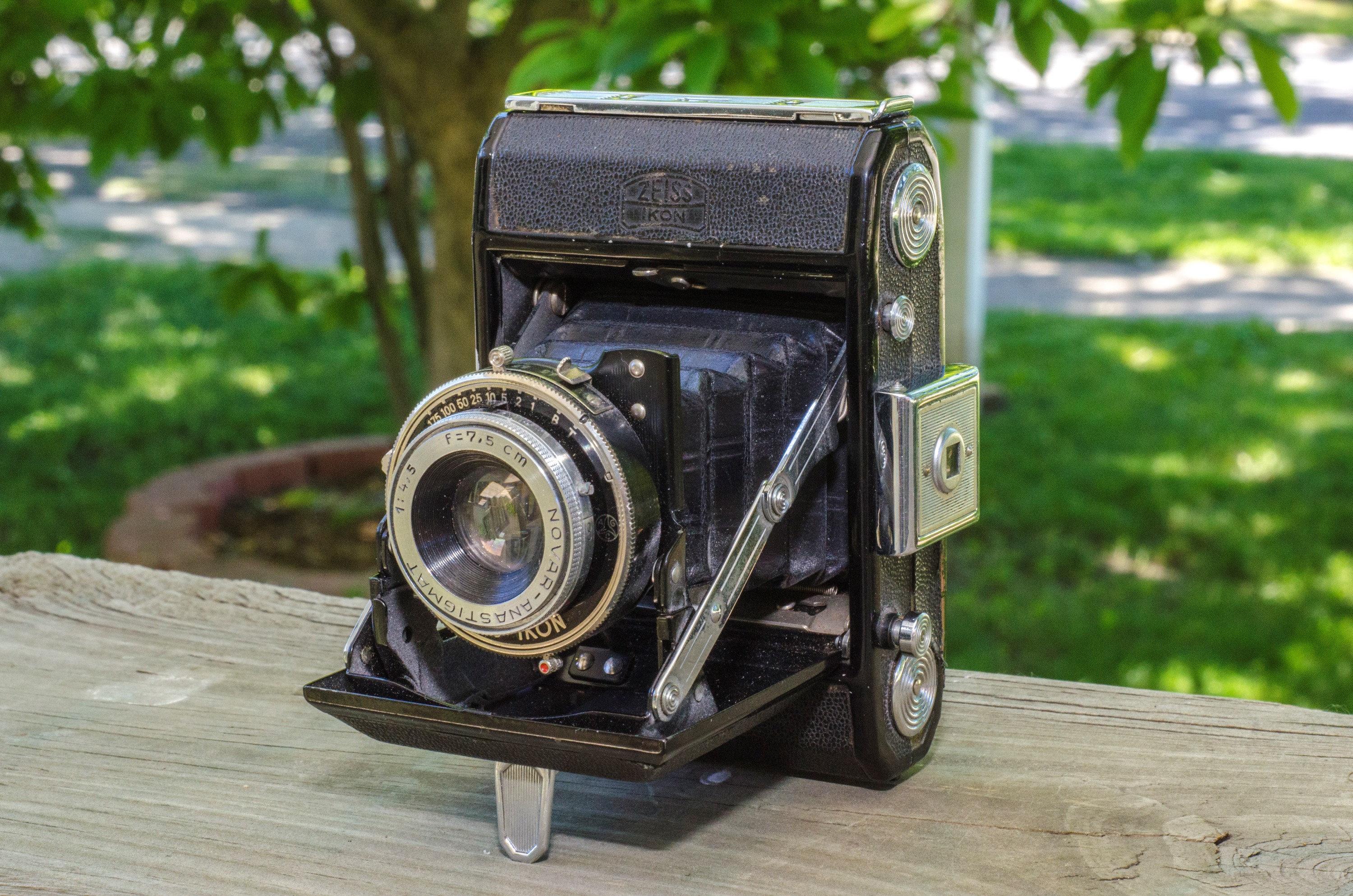
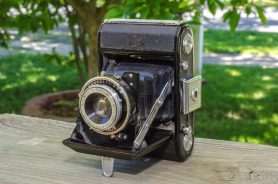
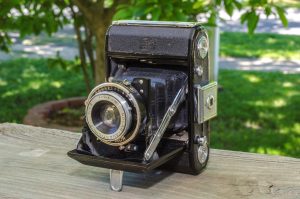






Really a very good and complete article! And thanks for the link to my test.
My 515 is fitted with a “Nettar” lens (but I believe it’s the same of Novar)… and I was such impressed by the I.Q. of this little camera to buy immediately another (this time it had a Novar) in similar good conditions. So, at least, I’ll have some repair parts for it………….. 😉
Mike – I love your site! I was hunting for info about my recently-acquired Zeiss Ikon Nettar 515 (f4.5 Klio), and you have put it to the test. Thanks for all the history and photo tests. I picked mine up from a guy selling other photo stuff on eBay. He was local, so I went to looky. Turns out that he had bought a storage locker at auction and was selling it out. I bought some other stuff, then he dove deep into a pile and pulled out the Nettar. Neither of us knew anything about it (I could guess!). He practically threw it into the deal.
Like yours, mine had sticky slow speeds. Otherwise, extremely clean. It had an old roll of Kodacolor inside – indicating that it hadn’t been shot since the mid-60’s! I took it my favorite camera repair, who cleaned the lens and shutter. I’ve bought some contrast filters, too. Really looking forward to working with this 6×4.5 format, and figuring out how to estimate focus! I love the compact feel of this camera, much less bulky than my Yashica MAT 124G.
One other odd detail about this camera is that it seems that the red windows are at the top, while modern film seems to mark the 6×4.5 frames on the bottom edge! Basically, I can’t see the Start or Frame numbers in the windows. I’m working this out, but wonder if you have any clues that you’ll share? From my tests, I think that one full turn of the winding knob should be enough film advance. It may be a little too much. I’ll just test and adjust. Maybe I’ll have a few rolls with only 15 frames….
You have made first class images from the Nettar. These old folders are still very usable today and immense fun. Last year my partner surprised me at Xmas with a Zeiss Ikon Ikonta 520/2. It has the Tessar lens and a full range of speeds on the rim~set shutter. Viewfinder is the pop~up variety and oiling the chrome hinges helped the camera to fully open when I press the button. Using Ilford FP4 (I’m in the UK) at 100 iso I get 8 6X9cm pictures per roll. I had contact prints made and they are quite viewable at this size. My camera is pristine so I sourced a leather case and strap on eBay uk.
Metered using a Weston Master 11 A’s it has the same speeds – 25-50-100-200 etc. Really great fun and strange looks from the plastic bodied digital boys. Serial number dates my camera to circa 1933. Its as well to know when they ask.
How do you align the numbers printed on modern films to the film windows?… I have the version with the two film windows by the way… I read somewhere that Kodak eliminated the double numbers from the film backings but what about other brands? According to the manual there should be a set of two numbers (1-1) (2-2) etc. that should perfectly align to left an right windows but Fomapan has only one number. How does this work? … (Sorry if I double posted… please delete)
If yours has two windows, then you shoot your first exposure when the number 1 is in the first window. Then advance the film until the number 1 is in the second window and shoot your second exposure. Then advance the film until the number 2 is in the first window and shoot your third exposure, then advance until number 2 is in the second window to shoot your fourth exposure and so on. Keep doing this until the number 8 is in the second window, at which time you’ve shot your sixteenth exposure.
Great article. I’ve just acquired a Nettar 515 in excellent condition as a gift. It has a Nettar Anastigmat 75mm f6.3 lens with the focus scale marked in feet. I haven’t used it yet but hope to put a roll of Tri-X through it soon.
Hey Mike — me again (Dana) — I just ended up with Nettar 515 also. Netter 7.5cm/f4.5 lens. Everything seems in working order — but mine also, as someone else noted, has double film-counter windows on the back — at the “top” — just under the view finder. They line up just to the “inside” of the metal film rollers inside. So I think if I did the suggestion of “1” in first window for first shot, then “1” in second window for second shot, the edges of the frames would overlap just a little. Yeah — just checked a 120 backing paper — the 6×4.5 numbers are on the “bottom” and the 6c9 numbers are on the top — where the two windows on mine are. Hmmmm. Hope to try it out with something around ASA 100 (can’t bring myself to use “ISO” with film!) this week if we get some sun. Much more compact than the 6×9 folders!!! Cheers! –Dana
Hi again, Mike – I’d like to add a couple of details about my Nettar 515 and ask a couple of questions. I have a Nettar 515 6×4.5 with Klio shutter and Novar 7.5cm f4.5 lens. Serial number F37649. Since I first wrote, I’ve had the camera CLA’d and the shutter is working great!
I have two film counting windows at the top. Interestingly, the inside of the back cover has this stamped:
Zeiss Ikon Film
6x9cm B2 2 1/4 x 3 1/4 in
So, maybe the 6×9 cover explains why I have two windows at the top! Did the factory originally install 6×9 covers on all these Nettars?
You noted that the 515 was built from 1937 to 1940. Is there a serial number list anywhere to tell when mine was built? Perhaps the year of manufacture is coded in the first two digits of the s/n? F37649 might be a hybrid serial number code for Year+serial, and might confirm 1937.
Best regards!
Kurt
Kurt — just took my 515 out for my first roll today (Nettar Anistigmat 7.5cm/f4.5 lens with Kilo shutter). The only CLA was me cleaning the front lens element and the inside (rear of the rear) lens element! And running the shutter through it’s paces for 15 minutes before loading the film. Shooting Ultrafine Extreme 100 B&W (cheap!) — was sunny today so I ended up at the faster shutter speeds and smaller apertures. I found that Mike’s recommendation of how to use the two frame-number windows with the 6×9 numbers was also in the manual — so that’s what I did. I think that I am a little more than 1/2 through the roll. Will try to get some more shots later this week. But — where did you get your CLA done? The serial number on mine, the best that I can make out, is J28684 — which would not seem to decode easily to any year in the correct range. Oh yeah — the inside of the back of mine also is stamped with 6×9 and the 6×9 frame size — which was definitely confusing at first — I don’t think that the back is nearly big enough for a real 6×9 camera — so maybe a manufacturing error? Or at the time 6×4.5 was not a recognized frame size for 120 film — so they are telling us to get 6×9 (12) film — and they had to use the two frame-counter windows to show the 6×9 numbers since there were no 6×4.5 numbers printed on backing paper back then? Well, it has been fun to use and compact — can’t wait to see the resuls…. Cheers — Dana
Hi Dana — Thanks for your reply! Manual…what manual?! Actually, the only manual I found online shows a camera with only one window, so it doesn’t explain the winding scheme for this particular (peculiar?) camera. The only trouble I have with this scheme is getting the first frame in position.
I live in Los Angeles, so I used Walter’s Camera Repair, http://www.walterscamerarepairs.com/ They’ve handled several of my cameras and lenses and I’ve been very happy with their consultations and repairs.
Thanks for the other info (busting my hopes of confirming the year from a coded serial number!). Maybe somebody has a serial number list….
I have wondered about whether I could find a back plate with lower windows. But since your’s seems to be the same model as mine, it was probably built that way, and we’ll have to struggle to adapt modern film markings to this old camera. Aside from wishing that the camera had lugs for a neckstrap, I love the feel of this little thing!
I’m going to start with 400 speed film because I use a color filters for my BW work. I feel the need – the need for speed!
Cheers!
Check way up at the top of the article where Mike lists the specs for the camera, and there is a link to photos of the manual on flickr. I was thinking of using my typical red/yellow/orange filters on a future roll if the camera is working OK — what would be your suggestion for getting filters onto this thing?
So far using the two frame-number windows and the 6×9 frame numbers (which appear upside-down) per Mike’s instructions and the manual has been working — at least the red windows are clear and I can see the printing on the backing paper and I have been careful to follow the procedure, and wind right after every shot. I think — I hope! 🙂 Well, with 16 shots it won’t be a disaster if I get a double-exposure or two, or skip a frame.
I’ll check with Walter’s Camera Repair and see how many houses I’ll have to mortgage to pay for CLA on my waaaaaay too many vintage cameras!!! I’d say I end up with about 75% working through my own cleaning and tweaking and minor fixes — but a good 25% do not work, or almost work but the repairs needed are beyond my meager capabilities.
And yes — it’s a great photographer-vest pocket sized camera, but I’d prefer to hang it around my neck.
Thanks!!! If I manage to get anything decent from it, I’ll probably put a few shots up on my Instagram (which I use to share interesting photos, most from vintage film cameras)….
–Dana
Dana,
Let me know where to see your photos. I’ll have to come up a few of my own, too.
The filter adapters are pretty common. They are just aluminum rings with metal tabs that you adjust to fit over the outer knurled grip at the front of the lens assembly. Very Old-Skool! This camera needs a 36mm adapter, which will fit Series 5 (sometimes Series V) filters. I just did a search on eBay for “series 5 36mm adapter ring” and got lots of hits at about $5. Of course, then look for Series 5 filters. For this camera, I also have a Tiffen Series 5 lens shade that screws onto the adapter ring and holds the filter while providing nice shade for the uncoated lens. I wish I could show a few photos, but haven’t figured out how to do that in this forum.
BTW, I find that Walters is not very expensive. Especially for a CLA. There are no expensive electronics to replace!
Look for “kiltbeardmedia” on Instagram and submit a follow request — let me know what Instagram name to look for so that I can approve it. I don’t have too many photos there — I am very picky with what I post. Having shot about 6500 photos since I got back into film 18 months ago. I do have some of those adapters for Series V, Series VI old filters — but yep, I’ll need an adapter. I have old Series V and similar filters, but most of them are not in great shape. Never thought to look for new ones — I’ll figure something out!
Thanks!!!
–Dana
My Instagram is Kurt_Dean.
I’m very lucky to have picked up a very nice set of very old Series V filters. I wish you luck. They’re worth having!
Kurt and Dana, thanks for the interesting conversation. I haven’t yet replied to this thread as I’ve enjoyed reading your back and forth!
Hah! Leaving me and Kurt to do all of the hard work! Stay safe!
Kurt — OK — approved your follow of me and I clicked to follow you (not a big fan of Instagram, but it’s free!). Yeah — I do need to upload some more example photos from my many other vintage cameras (and a few from my mirrorless). — Dana
Recently, I’ve been making myself busy by rebuilding my 1965 Beseler 45MCRX enlarger, but this thread has inspired me to pull out the 515 and GO SHOOT! Dana – thanks for the tips! And Mike, thanks for this great forum and write-up of the Nettar 515.
“Lens: 7.5cm f/4.5 uncoated Novar Anastigmat 4-elements”
Thats three elements.
Good catch! I updated it! 🙂
I have a collection of these type of folding medium cameras. However, for some reason, my 515/16 almost always is on me alongside a 35mm film camera. I am quite amazed at the photos that it produces. I own both Yashica Mat and Rolleiflex TLR camera which are fun to use, but the 515/16 provides similar output. I cannot recommend it enough.
I have this camera too and is one of my favorites 🙂
Greetings from germany